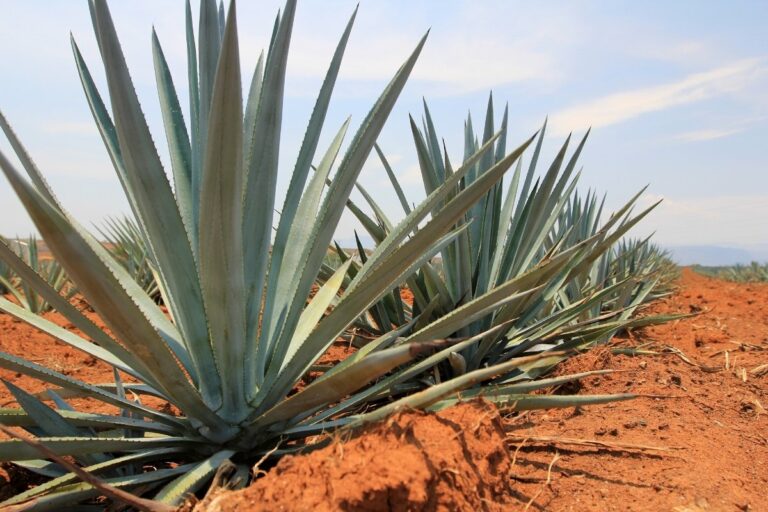Agaves are striking succulents that thrive in arid climates With their bold forms and tolerance for heat, these structural plants are ideal for xeric gardens However, agaves do have particular soil preferences. Choosing the right planting mix is key to growing lush, healthy agaves. This article will explore the soil needs of agave and how to prepare the ideal growing medium.
Agave Soil Requirements
When selecting soil for agaves focus on these factors
-
Drainage – Excellent drainage is crucial to prevent fungal rot in agave’s delicate roots, The soil must drain quickly after watering
-
Sand Content – Agaves naturally grow in sandy soils. A high sand content provides good aeration and free-draining structure.
-
Low Fertility – Highly fertile soils cause excessive growth and premature flowering in agave. Nutrient-poor soil is preferable.
-
Slightly Acidic pH – Agaves prefer a soil pH between 6.0-7.5. Avoid alkaline conditions above 7.5.
-
Organic Matter – While agaves don’t require rich soil, some organic content helps retain moisture and nutrients.
Soil Types for Growing Agave
Here are suitable soil options for agave:
Cactus Mix
Cactus potting mixes blend sand, perlite, and peat to create a fast-draining medium perfect for agaves. This commercial soil is an easy option for containers.
Sandy Loam
For in-ground planting, a sandy loam enriched with gravel provides the ideal blend of sand and organic matter. On clay soils, mix in sand to improve drainage.
Gravelly Soil
Agaves thrive in rocky, gravel-based soils with excellent drainage. Add gravel to planting holes in dense soils.
Bagged Cactus & Citrus Mix
Products like Miracle-Gro Cactus, Palm & Citrus soil mix provide balanced nutrition and aeration for agaves in pots or beds.
Soil Preparation Tips
-
Loosen compacted soils and amend with sand, gravel, or perlite to enhance drainage.
-
Mix compost into native soil to add organic matter, but avoid excessive fertility.
-
For containers, blend cactus mix with extra perlite or pumice.
-
Add gravel layer at the bottom of pots to improve drainage.
-
Plant agaves at same level as grown in nursery pots to prevent rot.
Potting Mix Recipe for Agaves
To make your own agave potting mix:
- 2 parts potting soil or compost for moisture and nutrients
- 2 parts perlite or pumice for porosity and drainage
- 1 part coarse sand or fine gravel to improve aeration
Combine ingredients thoroughly for even distribution in the potting medium. Adjust ratios based on climate and watering frequency.
Meeting Agave’s Soil Needs
Here are some key strategies for providing agaves with their ideal growing conditions:
-
Select fast-draining sites with sandy or gravelly soil.
-
Improve dense, clay soils by amending with sand, grit, or gravel.
-
For potted plants, use a commercial cactus/succulent mix or make your own blend.
-
Add extra perlite or pumice to potting mixes to increase drainage.
-
Avoid fertilizing agaves unless they show signs of nutrient deficiencies.
-
Water deeply but infrequently after plants are established.
-
Allow the soil to dry out between waterings.
-
Provide winter protection in zones prone to freezing.
Common Agave Soil Problems
Here are issues to watch for:
-
Poor drainage – Wet soil suffocates roots and leads to rot. Improve drainage immediately.
-
Too much fertility – Excess nitrogen stimulates floppy growth and flowering. Avoid fertilizer unless needed.
-
Soil compaction – Dense, compacted soil prevents air and water penetration. Loosen and amend with grit.
-
Extreme alkalinity – pH levels above 7.5 induce iron and nutrient deficiencies. Lower pH with elemental sulfur.
-
Salt buildup – Excess soluble salts in soil burn roots and leaves. Flush soils regularly to remove salts.
Signs Your Agave Needs Different Soil
Watch for these symptoms of unsuitable soil conditions:
- Wilting, drooping, or collapsing leaves
- Discolored, rotten roots or crown
- Stunted or excessive growth
- Leaf burn or scorching
- Widespread leaf spotting
- Failure to thrive and establish
If agaves exhibit any of these issues, reassess their soil environment and make adjustments to improve drainage, fertility, or pH levels.
Providing well-drained, sandy soil with low fertility allows agaves to flourish. Prepare planting sites properly and amend native soils to create the perfect medium. For potted agaves, use a specialized cactus mix blended with extra perlite or pumice. With suitable soil conditions, your agaves will reward you with years of striking architectural presence in hot, dry gardens.

Blog Network: Marthas Circle
Here at my Bedford, New York farm, my gardeners and outdoor grounds crew are busy gathering all the tropical plants, so they can be moved into their designated heated greenhouses for the winter season. This is also a good time to do any repotting if necessary – and this year, were transplanting some of my young agaves into larger containers.
Agave is a genus of monocots native to the hot and arid regions of the Americas. Many of them have elegant symmetrical rosettes made up of succulent, stiff and well-armed leaves with little or no stem. Some plants get up to 20-feet in diameter, while others grow only to dish-size. I love all agaves and have both large and small varieties in my collection. In fact, many of the plants started as offshoots, or pups, which were removed from adult specimens and replanted right in my greenhouse.
Bagged Soil | How to Choose the Right One for Your Garden
FAQ
What is the best soil for agave?
Can you plant agave in potting soil?
How do you make agave soil mix?
When should I repot my agave plant?
